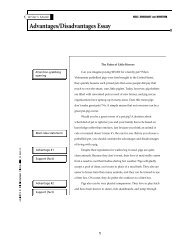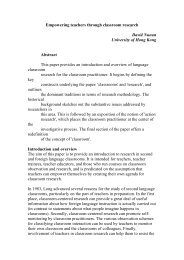Using Interviews as Research Instruments - CULI
Using Interviews as Research Instruments - CULI
Using Interviews as Research Instruments - CULI
You also want an ePaper? Increase the reach of your titles
YUMPU automatically turns print PDFs into web optimized ePapers that Google loves.
espondent to elucidate further if necessary, and to establish his<br />
own style of conversation.<br />
Additional questions can be <strong>as</strong>ked and some may be questions that have<br />
not been anticipated in the beginning of the interview. Note taking or<br />
tape recording documents the interview. This type of interview gives the<br />
researcher opportunities to probe for views and opinions of the<br />
interviewee. Probing is a way for the interview to explore new paths<br />
which were not initially considered (Gray, 2004, p. 217). Having“ … key<br />
themes and sub-questions in advance lies in giving the researcher a sense<br />
of order from which to draw questions from unplanned encounters<br />
(David, & Sutton, 2004, p. 87).”<br />
The researcher conducting semi-structured interviews is freer one than<br />
conducting a structured interview (Kajornboon, 2004, p. 75) in which the<br />
interviewer does not have to adhere to a detailed interview guide. Patton<br />
(2002, p. 343) recommends to “ … explore, probe, and <strong>as</strong>k questions that<br />
will elucidate and illuminate that particular subject … to build a<br />
conversation within a particular subject area, to word questions<br />
spontaneously, and to establish a conversational style but with the focus<br />
on a particular subject that g<strong>as</strong> been predetermined.”<br />
The strengths of semi-structured interviews are that the researcher can<br />
prompt and probe deeper into the given situation. For example, the<br />
interviewer inquires about using computers in English language teaching.<br />
Some respondents are more computer literate than others are. Hence,<br />
with this type of interview the interviewers are able to probe or <strong>as</strong>ked<br />
more detailed questions of respondents’ situations and not adhere only to<br />
the interview guide. In addition, the researcher can explain or rephr<strong>as</strong>e<br />
the questions if respondents are unclear about the questions.<br />
The drawbacks are inexperienced interviewers may not be able to <strong>as</strong>k<br />
prompt questions. If this is the c<strong>as</strong>e, some relevant data may not be<br />
gathered. In addition, inexperienced interviewers may not probe into a<br />
situation. For example, if the respondents do not know how to use<br />
computers and do not want to use them in language teaching, the<br />
interviewer needs to probe and find out the re<strong>as</strong>ons and <strong>as</strong>k for<br />
explanations.<br />
Unstructured <strong>Interviews</strong><br />
This type of interview is non-directed and is a flexible method. It is more<br />
c<strong>as</strong>ual than the aforementioned interviews. There is no need to follow a





